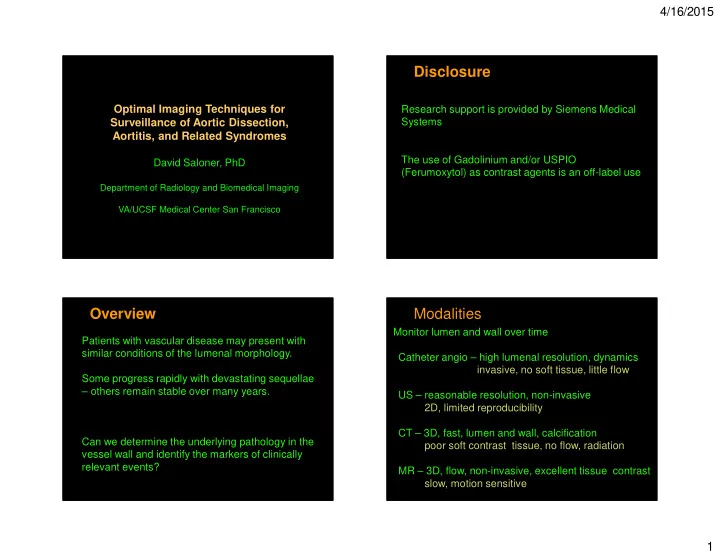

4/16/2015 Disclosure Optimal Imaging Techniques for Research support is provided by Siemens Medical Surveillance of Aortic Dissection, Systems Aortitis, and Related Syndromes The use of Gadolinium and/or USPIO David Saloner, PhD (Ferumoxytol) as contrast agents is an off-label use Department of Radiology and Biomedical Imaging VA/UCSF Medical Center San Francisco Overview Modalities Monitor lumen and wall over time Patients with vascular disease may present with similar conditions of the lumenal morphology. Catheter angio – high lumenal resolution, dynamics invasive, no soft tissue, little flow Some progress rapidly with devastating sequellae – others remain stable over many years. US – reasonable resolution, non-invasive 2D, limited reproducibility CT – 3D, fast, lumen and wall, calcification Can we determine the underlying pathology in the poor soft contrast tissue, no flow, radiation vessel wall and identify the markers of clinically relevant events? MR – 3D, flow, non-invasive, excellent tissue contrast slow, motion sensitive 1
4/16/2015 Modalities CT Angiography Monitor lumen and wall over time Excellent for rapid overview of aortic anatomy Catheter angio – high lumenal resolution, dynamics invasive, no soft tissue, little flow Single breathhold acquisitions US – reasonable resolution, non-invasive Excellent lumenal depiction for identifying 2D, limited reproducibility geometric morphology of lumen and wall CT – 3D, fast, lumen and wall, calcification Identify inflammatory responses in the wall poor soft contrast tissue, no flow, radiation In dissection, good visualization of intimal tear, MR – 3D, flow, non-invasive, excellent tissue contrast intimal flap and reentry point slow, motion sensitive Chest Pain Aortic Dissection Convex towards false Systole 2 months later Diastole 2
4/16/2015 Aortic Dissection Aortic Dissection Early Late CT Angiography Aorta Wall MR Imaging MR offers many acquisitions with different contrast properties Iodinated contrast concerns Excellent flow visualization Concern in surveillance for multiple radiation sessions No radiation Limited soft tissue information 3D acquisitions with good reproducibility No flow information Potential for imaging inflammation 3
4/16/2015 Aortic Disease Aortic Dissection - MRI Post Contrast Fat Sat Black Blood MRA CINE Black Blood Aorta MR Imaging CE-MRA 15 sec Gd AAAs are fusiform aneurysms that often present with Excellent lumenal large volumes of intralumenal thrombus visualization Slab-selective 3D coronal acquisition For lumen: Bolus timing is key 4
4/16/2015 Improved Contrast Aorta Wall MR Imaging DANTE SPACE AAAs are fusiform aneurysms that often present with large volumes of intralumenal thrombus High contrast between wall and lumen using suppression of flow signal – black blood MR * * Slab-selective 3D coronal acquisition – 1.3mm isotropic; Tacq = 7 minutes * Large volumes of slow and recirculating flow present challenges for black blood MRI Breathing motion generates motion-related artifacts * Comparison with CT AAA Wall Imaging CTA DANTE-SPACE 3D SPACE provides images with 1.3mm**3 isotropic resolution A2 B2 Motion of abdominal organs can be problematic For serial comparison - lumenal segmentation is A1 A3 B1 B3 straightforward on MRA but outer-wall is difficult All components of thrombus are isointense on CTA 5
4/16/2015 Results CE-MRA (USPIO) Molecular Imaging Research DANTE-SPACE Post Ultrasmall Paramagnetic Iron Oxides (USPIO) in Ferumoxytol the wall as a marker of inflammation? D-SPACE Scavenged by activated macrophage Potentially differentiate stable from active (growing) aneurysms CT Ferumoxytol Multi-modality Imaging in a Rapidly Growing Iliac Artery Aneurysm Comparison of USPIO (Ferumoxytol) with FDG-PET CT 3D – black blood vessel wall imaging 6
4/16/2015 4D Flow Measurement Using MRI Measure each component of velocity at all points in the 3D volume At any given point in time – connect the vectors to show streamlines Follow the vectors from one point in the cardiac cycle to the next to show path lines 4D Flow pathlines 4D Flow Streamlines 7
4/16/2015 4D Flow pathlines 4D Flow Measurement Using MRI Flow patterns reflect the likelihood of thrombus layering Flow patterns reflect the presence of disordered or turbulent flow Flow patterns differentiate true and false lumen Velocity field – recirculation, jets, asymmetric flow, vortical flow Derived descriptors – wall shear stress, pressure drops, turbulence kinetic energy MR velocity methods require: MR velocity methods require: A. Breathholding 20% 20% 20% 20% 20% a. Breathholding B. Administration of contrast agents b. Administration of contrast agents C. Cardiac synchronization c. Cardiac synchronization D. a and c E. b and c d. a and c g n c c . n . o d d a d i i n n r t a l t a a e. b and c o n z a b h o i n h c o t a f r o h e r n c n B o y i t s a c r a t s i d i n r a m i C d A :10 8
4/16/2015 MR velocity methods require: Compared to CT, advantages of MR are: a. Breathholding a. Fast acquisition b. Administration of contrast agents b. Improved soft tissue contrast c. Cardiac synchronization c. Insensitivity to flow artifacts d. a and c d. a and c e. b and c e. b and c Imaging the Aorta Compared to CT, advantages of MR are: a. Fast acquisition Multiple modalities available b. Improved soft tissue contrast For surveillance: non-invasive c. Insensitivity to flow artifacts reproducible structural and functional d. a and c good contrast lumen and wall e. b and c 9
4/16/2015 Radiology Siemens Medical Systems Chengcheng Zhu, PhD Gerhard Laub, PhD Henrik Haraldsson, PhD Sinyeob Ahn, PhD Farshid Faraji, MS Cecilia Huang, MS Florent Seguro, MD Michael Hope, MD Vascular surgery Chris Owens, MD Warren Gasper, MD Joseph Rapp, MD Hugh Alley NIH (NINDS, NHLBI) 10
Recommend
More recommend